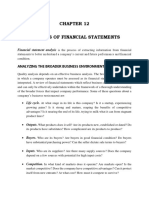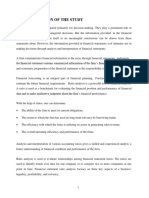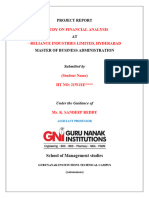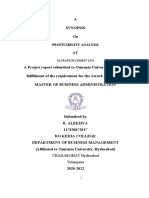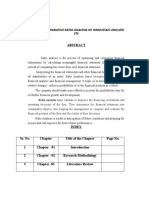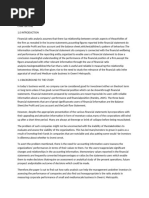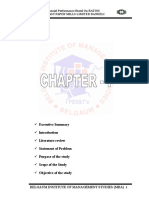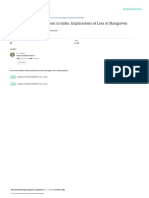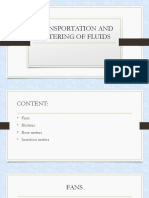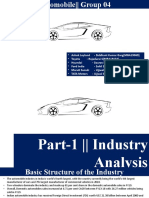A Study On Ratio Analysis in Heritage: Vol 11, Issue 5, May/ 2020 ISSN NO: 0377-9254
A Study On Ratio Analysis in Heritage: Vol 11, Issue 5, May/ 2020 ISSN NO: 0377-9254
Uploaded by
DedipyaCopyright:
Available Formats
A Study On Ratio Analysis in Heritage: Vol 11, Issue 5, May/ 2020 ISSN NO: 0377-9254
A Study On Ratio Analysis in Heritage: Vol 11, Issue 5, May/ 2020 ISSN NO: 0377-9254
Uploaded by
DedipyaOriginal Title
Copyright
Available Formats
Share this document
Did you find this document useful?
Is this content inappropriate?
Copyright:
Available Formats
A Study On Ratio Analysis in Heritage: Vol 11, Issue 5, May/ 2020 ISSN NO: 0377-9254
A Study On Ratio Analysis in Heritage: Vol 11, Issue 5, May/ 2020 ISSN NO: 0377-9254
Uploaded by
DedipyaCopyright:
Available Formats
Vol 11, Issue 5,May/ 2020
ISSN NO: 0377-9254
A STUDY ON RATIO ANALYSIS IN HERITAGE
1
R.Anusha, 2K.Yamini Bhargavi, 3Dr. Y.Venkata Rangaiah
1
MBA Student, 2Assistant Professor, 2Associate Professor &HOD
DEPARTMENT OF MBA
St. Martin's Engineering College, HYDERABAD
ABSTRACT Mining industries are capital intensive; hence a lot of
This paper outlines a financial statement analysis for money is invested in it. So before investing in such
use in equity valuation. Standard profitability analysis companies one has to carefully study its financial
is incorporated, and extended, and is complemented condition and worthiness. Unfortunately very limited
with an analysis of growth. The perspective is one of work has been done on analysis and interpretation of
forecasting payoffs to equities. So financial statement financial statements of Indian for mining companies.
analysis is presented first as a matter of pro forma An attempt has been carried out in this project to
analysis of the future, with forecasted ratios viewed as analyze and interpret the financial statements of five
building blocks of forecasts of payoffs. The analysis coal and non- coal mining companies.
of current financial statements is then seen as a matter 1. INTRODUCTION
of identifying current ratios as predictors of the future Financial statements are prepared primarily for
ratios that drive equity payoffs. The financial decision-making. They play a prominent role in setting
statement analysis is hierarchical, with ratios lower in the framework of managerial decisions. But the
the ordering identified as finer information about those information provided in the financial statements is not
higher up. To provide historical benchmarks for an end in itself as no meaningful conclusions can be
forecasting, typical values for ratios are documented drawn from these statements alone. However, the
for the periods, along with their cross-sectional information provided in financial statements is of
variation and correlation. And, again with a view to immense use in making decisions through analysis and
forecasting, the time series behavior of many of the interpretation of financial statements.
ratios is also described and their typical "long-run,
steady-state" levels are documented. A firm communicates financial information to the
In this paper, we compare ratio analysis with the data users through financial statements, and reports the
envelopment analysis approach. It is shown that using financial statement contains summarized information
ratio analysis implies that a one multidimensional of the firm’s financial affairs. Organized and
space is projected onto other subspaces many times. systematic preparation of the financial statement is the
As a result, significant distortion of the performance responsibility of top management.
assessment of units takes place. Our theoretical results Financial forecasting is an integral part of
are validated by computational experiments on the financial planning. Forecasting uses past data to
data taken from financial accounts. estimate the future financial requirements. Ratio
Financial statements are used as a management tool analysis is a powerful tool of financial analysis. A
primarily by company executives and investor’s in ratio is used as a benchmark for evaluating the
assessing the overall position and operating results of financial position and performance of financial data
the company. and to make qualitative judgment about the firm’s
Analysis and interpretation of financial statements financial performance.
help in determining the liquidity position, long term With the help of ratios, one can determine:
solvency, financial viability and profitability of a firm. The ability of the firm to meet its current
Ratio analysis shows whether the company is obligations.
improving or deteriorating in past years. Moreover, The extent to which the firm has used its
Comparison of different aspects of all the firms can be long-term solvency by borrowing funds.
done effectively with this. It helps the clients to decide The efficiency with which the firms is
in which firm the risk is less or in which one they utilizing its assets in generating sales
should invest so that maximum benefit can be earned. revenue.
www.jespublication.com Page No:713
Vol 11, Issue 5,May/ 2020
ISSN NO: 0377-9254
The overall operating efficiency and of finance. The scope of the study is confined to the
performance of the firms. sources that Heritage Foods (India) Limited tapped
Analysis and interpretation of various over the years under study i.e. 2014-19.
accounting ratios gives a skilled and experienced Objectives of the study
analyst, a better understanding of financial To examine the financial performance of the
condition and performance of the firm. Heritage Foods (India) Limited for the
period of 2014 to 2019.
Ratio analysis is used to evaluate relationships among To analyses interpret and to suggest the
financial statement items. The ratios are used to operational efficiency of the Heritage Foods
identify trends over time for one company or to (India) Limited. By comparing the balance
compare two or more companies at one point in time. sheet & profit & loss A/c.
Financial statement ratio analysis focuses on three key To critically analyse the financial
aspects of a business: liquidity, profitability, and performance of the Heritage Foods (India)
solvency. Limited. With the help of ratios.
Need for the study To assess the working capital employed by
the Heritage Foods (India) Limited.
The problems, which are common to most of To examine feasibility of present system of
the public sectors under taking, are materials scarcity. managing working capital.
Capacity utilization and mainly working capital To understand how the company finances its
requirements and Heritage Foods (India) Limited. working capital
are no exception. Thus the importance of the study To analyze the financial performance of the
reveals as to how efficiently the working capital has company with reference to working capital.
been used so far in the organization. To give some suggestions to the
management based on the information
Ratio Analysis is one of the key areas of financial studied.
decision-making. It is significant because, the LIMITATIONS
management must see that an excessive investment in The study is based on only secondary data.
current assets should protect the company from the The period of study was 2014-19 financial
problems of stock-out. Current assets will also years only.
determine the liquidity position of the firm. Another limitation is that of standard ratio
with which the actual ratios may be compared
The goal of Ratio Analysis is to manage the firm generally there is no such ratio, which may be
current assets and current liabilities in such a way that treated as standard for the purpose of
a satisfactory level of working capital is maintained. comparison because conditions of one
If the firm cannot maintain a satisfactory level of concern differ significantly from those of
working capital, it is likely to become insolvent and another concern.
may be even forced into bankruptcy. The accuracy and correctness of ratios are
totally dependent upon the reliability of the
Scope of the study data contained in financial statements on the
basis of which ratios are calculated.
The scope of the study is limited to collecting
financial data published in the annual reports of the II. RESEARCH METHODOLOGY
company every year. The analysis is done to suggest
the possible solutions. The study is carried out for 5 Use and Significance of Ratio Analysis
years (2014-19).
The ratio is one of the most powerful tools of
A study of the Ratio Analysis involves an financial analysis. It is used as a device to analyze and
examination of long term as well as short term sources
that a company taps in order to meet its requirements
www.jespublication.com Page No:714
Vol 11, Issue 5,May/ 2020
ISSN NO: 0377-9254
interpret the financial health of enterprise. Thus ratios quantitative relationship between two items variables.
have wide applications and are of immense use today. The relationship can be expressed as
Data sources Percentages
The study is based on secondary data. Fractions
However the primary data is also collected to fill the Proportion of numbers
gap in the information.
Primary data will be through regular These alternative methods of expressing
interaction with the officials of Heritage items, which are related to each other, are for purposes
Foods (India) Limited. of financial analysis refer to as Ratio analysis.
Secondary data collected from annual reports
and also existing manuals and like company RATIO ANALYSIS
records balance sheet and necessary records.
Alexander Wall is considered to be the
III. FINANCIAL ANALYSIS pioneer of ratio analysis. He presented after a serious
a detailed system of ratio analysis in 1990. He
A basic limitation of the traditional financial explained that the work of interpretation could be
statements comprising the balance sheet and the profit made easier by establishing quantitative relationships
and loss account is that they don’t give all information between the facts given in the financial statements.
related to the financial operations of the firm. The focus of financial analysis is on key
Nevertheless, they provide some extremely useful figures in the financial statements and significance
information to the extent that the balance sheet mirrors relationships that exist between there. This analysis
the financial position on a particular date in terms of relationship between component parts of financial
the structure of assets, liabilities and owner’s equity statements to obtain a better understanding of the
and so on, and the profit and loss account shows the firm’s position and performance.
results of operation during a certain period of times in
terms of the revenue obtained and the cost incurred
during the year. Thus the financial position and CLASSIFICATION OF RATIOS TYPES OF
operations statement provides a summarized a view of RATIOS
the financial position and operations of the firm. The
analysis of financial statement is thus an important aid The ratios can be classified into four types:
to financial analysis.
LIQUIDITY RATIOS
The first task of the financial analyst is to Liquidity ratios measure the firm’s ability to meet
select the information relevant to the decisions under current obligations.
consideration from the total information from the total I. Current Ratio
information contained in the financial statements. The II. Quick Ratio
second step is arranged the information in the way to III. Cash Ratio
highlight significant relationship. The final step is IV. Interval Ratio
interpretation and drawing of inferences and V. Net Working Capital Ratio
conclusions. In the brief financial analysis are the
LEVERAGE RATIOS
processes of selection, relation and evaluation.
Leverage ratios show the proportions of debt and
equity in financing the firm’s assets.
Ratio analysis is a widely used tool of
I. Debt Equity Ratio
financial analysis. It is defined as the systematic use
II. Capital Equity Ratio
of ratio to interpret financial statements so that the
III. Proprietary Ratio
strength and weakness of a firm as well as its historical
performance and current financial conditions can be
determined. The term Ratio refers to the numerical or
www.jespublication.com Page No:715
Vol 11, Issue 5,May/ 2020
ISSN NO: 0377-9254
ACTIVITY RATIOS 201 168.7 116.916 175.59 164.888 -
Activity ratios reflect the firm’s efficiency in utilizing 5- 8 043 722 6.8
its assets. 16 1
I. Inventory Ratio 201 164.6 97.5234 170.73 97.2321 -
II. Fixed Assets Turnover Ratio 6- 032 886 6.1
III. Total Assets Turnover Ratio 17 3
IV. Current Assets Turnover Ratio 201 208.4 126.646 185.63 108.727 22.
V. Collecting Period of Debtor Ratio 7- 6 416 23 83
VI. Working Capital Turnover Ratio 18
201 235.2 112.827 190.33 102.531 44.
ADVANTAGES OF RATIO ANALYSIS 8- 0 401 918 87
19
Ratio analysis simplifies the comprehension
of financial statement.
Ratio analysis provides data for inter firm Chart Title
comparison
300
Ratio analysis helps in planning forecasting
200
trends in cost, sales, profit and other related
facts are revealed by the past ratios and future 100
events can be forecast on the basis of such 0
-100 2014-15 2015-16 2016-17 2017-18 2018-19
trends.
Ratio may be used as an instrument of Current Assets Growth Rate (%)
management control particularly in the area
Current Liabilities Growth Rate (%)
of sales cost.
A ratio helps in investment decision to make Net W.C
profitable investment.
Interpretation:
Ratios also facilitate the function of
communication. It can be easily conveyed
The current assets of the organization are more as
through the ratio as what as happened during
compared with current liabilities but at the year 2018-
the two intervening periods.
2019 the financial position i.e. turnover of current
Ratios may also be used as a measure of
year is high i.e. 44.87.
efficiency.
IV. DATA ANALYSIS AND
WORKING CAPITAL TURNOVER RATIO
INTERPRETATION
(All amounts are in Cr)
Size and growth of current assets and liabilities and Year
Networking
Net working capital of Heritage Foods (India) Sales Ratio
Capital
Limited during the period 2014-15 TO 2018-19
2014- 37.87
1096.18
(All amounts are in Cr) 15 28.9458674
Ye Curr Growt Curre Growt Net 2015- -6.81 -
1393.41
ar ent h Rate nt h Rate W. 16 204.612335
Asset (%) Liabili (%) C 2016- -6.13 -
1601.81
s ties 17 261.306688
201 144.3 100 106.49 100 37. 2017- 22.83
1722.04
4- 6 87 18 75.4288217
15 2018- 44.87
2,072.97
19 46.1994651
www.jespublication.com Page No:716
Vol 11, Issue 5,May/ 2020
ISSN NO: 0377-9254
Chart Title
Chart Title 3000
2000 2000
1000 1000
0
0
2014-15 2015-16 2016-17 2017-18 2018-19
2014-15 2015-16 2016-17 2017-18
-1000 Net Credit Sales Avg. Debt Ratio
Sales Networking Capital Ratio
From the above table, it is observed that the Heritage
Turnover Ratio: Foods (India) Limited debtor’s turnover ratio shows
a good sigh. The company noted a maximum ratio of
Debtors Turnover Ratio expresses the relationship 124.41 in the year 2015-16 and the minimum ratio in
between debtors and sales. A high Debtors Turnover the year of 2014-15
Ratio or low Debt collection period is indicative of
sound credit management policy. If we observed the above table the ratio is increasing
the year 2014-15 to 75.91 in the year 2015-16 in the
Table shows Debtors Turnover Ratio of Heritage year but it is increased to 103.67 in the year 2016-17.
Foods (India) Limited. during 2014-15 to 2018-19. It shows a good sign for the company. present year it
is 85.51i.e on 2018-19.
(All amounts are in Cr)
Net Current Ratio:
Avg. It is the ratio of the current assets current liabilities this
Year Credit Ratio
Debt ratio is used to know the company’s ability to meet its
Sales
2014-15 75.91274 current obligations. The standard norm for the current
1096.18 14.44 ratio is 2:1
24
2015-16 124.4116 Current ratio = current Assets / Current liabilities.
1393.41 11.20 Table showing current ratio of Heritage Foods
07
2016-17 106.2913 (India) Limited during the period 2014-15 to 2018-
1601.81 15.07 19
07
2017-18 103.6748 (All amounts are in Cr)
1722.04 16.61
94
Current Current
2018-19 85.51856 Year Ratio
2072.97 24.24 Assets Liabilities
43
2014-
144.36 106.49 1.35562
15
2015-
168.78 175.59 0.961216
16
2016-
164.6 170.73 0.964095
17
2017-
208.46 185.63 1.122987
18
2018-
235.2 190.33 1.235748
19
www.jespublication.com Page No:717
Vol 11, Issue 5,May/ 2020
ISSN NO: 0377-9254
without any fit falls up to 2014-15. But in the
Chart Title year 2015-16 it is declined, and again it has
300 increased in the year 2017-18. Good
inventory management is good sign for
200 efficient management
5. Total Assets turnover ratio of Heritage
100
Foods (India) Limited is not satisfactory
0 because it is always below one, except in the
2014-15 2015-16 2016-17 2017-18 2018-19 year 2017-18 having a value of 17.58.
6. Return on investment is not satisfactory. This
Current Assets Current Liabilities Ratio
indicates that the company’s funds are not
being utilized in a better way.
It is observed that the Heritage Foods (India) VI. Suggestions
Limited current rationing a increasing trend; 1. Improve position funds should be utilized
The company’s liquidity position is satisfactory the properly.
current ratio increased slightly up to 2015-16. also in 2. Better Awareness to increase the sales is
2018-19 it inclined because of increase in current suggested.
liabilities and assets, and then it started to increase as 3. Cost cut down mechanics can be employed.
1.23. If the company maintains to increase the ratio it 4. Better production technique can be
can meet obligations. employed.
5. The investment on raw material should be
Quick Ratio:
Quick ratio is relation between quick assets and made as per the requirement. Unnecessary
current liabilities. The term quick assets, which can be investment may block up the funds.
converted into cash with a short notice. This category 6. Neither too high nor too low inventory
also includes cash bank balances short – term turnover ratios may reduce profit and
investments and receivables. liquidity position of the industry. So, proper
balance should be made to increase profits
and to ensure liquidity.
Quick ratio = Quick Assets / current liabilities
7. The raw material should be acquired from the
V. Findings right source at right quality and at right cost.
8. The process that was being used by Heritage
1. The Heritage Foods (India) Limited net Foods (India) Limited with the purchasing
working capital is satisfactory between the department should undergo changes; so that,
years 2017-18 since it shows decreasing it seeks enhance the celerity of the delivery of
trend ; but after that it is in declining position. a product without compromising its quality
2. The current ratio of Heritage Foods (India) by improving the utilization of materials,
Limited is satisfactory during the period of labor and equipment.
study 2014-15 to 2017-18. It is increased but VII. Conclusions
after that it is declining.
3. The average quick ratio of Heritage Foods 1. The Heritage Foods (India) Limited Net
(India) Limited is not good though the quick Profit Ratio is showing profit in the year .
ratio is showing maximum value of 0.50 in This event is an expected one because since
the year 2017-18 and then it is declining to be from the previous two years it is showing the
deal. Fixed assets turnover ratio of Heritage decline stage in Net Profit Ratio.
Foods (India) Limited increased. The 2. The Heritage Foods (India) Limited Gross
company has to maintain this. Profit Margin of Heritage Foods (India)
4. Inventory turnover ratio of Heritage Foods Limited increases in decreases due to the
(India) Limited is also increased gradually, increase in sales
www.jespublication.com Page No:718
Vol 11, Issue 5,May/ 2020
ISSN NO: 0377-9254
3. Profit Margin of Heritage Foods (India)
Limited is decreasing and showing negative
profit because there is increase in the price of
copper
4. The Heritage Foods (India) Limited Net
Working Capital Ratio is satisfactory.
5. The Heritage Foods (India) Limited return
on Total Assets ratio shows a negative sign in
the year 2014-15
6. The Operating Ratio of Heritage Foods
(India) Limited isn’t satisfactory. Due to
increase in cost of production, this ratio is
decreasing. So the has to reduce its office
administration expenses
BIBLIOGRAPHY
BOOKS
Financial Management Written By M.Y. Khan & P.K.
Jain
Financial Management Written By Prasanna Chandra
Financial Management Written By I. M. Pandey
Financial Management Written By S. N. Maheswari
Annual reports of the company---2015-2019.
www.heritageindia.com
www.damodaram.com
www.retailindia.com
www.investopedia.com
www.valuebasedmanagement.net
www.jespublication.com Page No:719
You might also like
- Ansi Z359.6 - 16Document60 pagesAnsi Z359.6 - 16Howard Velasquez100% (1)
- Anandani, Manini J - Mandodari - Queen of LankaDocument224 pagesAnandani, Manini J - Mandodari - Queen of LankaDedipyaNo ratings yet
- Group 2 Analysis of Financial StatementsDocument37 pagesGroup 2 Analysis of Financial StatementsA cNo ratings yet
- Hydraulic Fracturing in Tight Gas ReservoirsDocument35 pagesHydraulic Fracturing in Tight Gas ReservoirsDedipya0% (1)
- 5.2 Auditing Construction and Real Estate Industry - AsynchDocument21 pages5.2 Auditing Construction and Real Estate Industry - AsynchJoh Aguilar100% (1)
- Chapter 2 - Cost Terms, Concepts and ClassificationsDocument55 pagesChapter 2 - Cost Terms, Concepts and ClassificationsMarriel Fate CullanoNo ratings yet
- Foreign Currency TranslationDocument38 pagesForeign Currency TranslationAnmol Gulati100% (1)
- Project ODYSSIA NewDocument96 pagesProject ODYSSIA Newmanesh100% (2)
- Ratio Analysis Heritage Foods Ltd-2Document64 pagesRatio Analysis Heritage Foods Ltd-2Varun ThatiNo ratings yet
- Ratio Analysis of Heritage Foods India LTD 2015Document75 pagesRatio Analysis of Heritage Foods India LTD 2015Vijay ReddyNo ratings yet
- Rutu Final Project DraftDocument42 pagesRutu Final Project Draftaniketawari94No ratings yet
- 830pm 50.epra Journals-5705Document7 pages830pm 50.epra Journals-5705DedipyaNo ratings yet
- 303am 62.EPRA Journals-4113Document6 pages303am 62.EPRA Journals-4113Amogh AroraNo ratings yet
- Ratio AnalysisDocument47 pagesRatio AnalysisyasarNo ratings yet
- Module 3 Analysis and Interpretation of Financial StatementsDocument23 pagesModule 3 Analysis and Interpretation of Financial StatementsRonald Torres100% (1)
- Accounting Ratios Information: An Instrument For Business Performance AnalysisDocument6 pagesAccounting Ratios Information: An Instrument For Business Performance AnalysisEditor IJTSRDNo ratings yet
- Chapter - 1 Introduction and Design of Study Financial Statement AnaylysisDocument47 pagesChapter - 1 Introduction and Design of Study Financial Statement Anaylysisaditya dhuparNo ratings yet
- 66 105 1 SMDocument9 pages66 105 1 SMs3979517No ratings yet
- E0071 Financial Analysis of Reliance Industries LimitedDocument87 pagesE0071 Financial Analysis of Reliance Industries LimitedwebstdsnrNo ratings yet
- Profitability Analysis: CHADARGHAT Hyderabad TelanganaDocument10 pagesProfitability Analysis: CHADARGHAT Hyderabad TelanganakhayyumNo ratings yet
- Chapter - 1 Introduction: 1.1 Background of The StudyDocument78 pagesChapter - 1 Introduction: 1.1 Background of The StudyPRIYA RANANo ratings yet
- Ratio Analysis With Referance To SR Steel Ind ProjectDocument57 pagesRatio Analysis With Referance To SR Steel Ind ProjectshaileshNo ratings yet
- Sameema ContentsDocument62 pagesSameema ContentsSAUMYA MNo ratings yet
- UntitledDocument68 pagesUntitledSurendra SkNo ratings yet
- A Project Report On Financial Performance Based On Ratios at HDFC BankDocument74 pagesA Project Report On Financial Performance Based On Ratios at HDFC BankBabasab Patil (Karrisatte)No ratings yet
- Sai Naik ProjectDocument78 pagesSai Naik ProjectSAIsanker DAivAMNo ratings yet
- ProjectDocument27 pagesProjectrajanikant DesaiNo ratings yet
- Study of Comparative Ratio AnalysisDocument68 pagesStudy of Comparative Ratio Analysisbalu mughalNo ratings yet
- Performance Analysis Through Financial MDocument5 pagesPerformance Analysis Through Financial Mshsyed.areNo ratings yet
- FinancialPerformanceAnalysis GIMDocument16 pagesFinancialPerformanceAnalysis GIMdemionNo ratings yet
- A Project Report On Financial Ratios at B.D.K. Ltd. Hubli Project ReportDocument69 pagesA Project Report On Financial Ratios at B.D.K. Ltd. Hubli Project Reportsatish pawarNo ratings yet
- Ratio Analysis About S.R. Steel IndustriesDocument51 pagesRatio Analysis About S.R. Steel IndustriesshaileshNo ratings yet
- E0095 Financial-Performance-of-Private and Nationalized BanksDocument53 pagesE0095 Financial-Performance-of-Private and Nationalized BankswebstdsnrNo ratings yet
- A Project Report On Financial Performance Based On Ratios at HDFC BankDocument75 pagesA Project Report On Financial Performance Based On Ratios at HDFC Banksudam merya100% (1)
- "A Study of Financial Statement Analysis Through Ratio Analysis at Sids Farm Pvt. LTDDocument14 pages"A Study of Financial Statement Analysis Through Ratio Analysis at Sids Farm Pvt. LTDAbdul WadoodNo ratings yet
- Divya - FsaDocument11 pagesDivya - Fsamohammed khayyumNo ratings yet
- IJMS V6 I3 Paper 5 1273 1275Document3 pagesIJMS V6 I3 Paper 5 1273 1275tamiltop886No ratings yet
- UDEJIMBA FAVOUR PROJECT-WPS OfficeDocument33 pagesUDEJIMBA FAVOUR PROJECT-WPS Officesamuelchibuzor2019No ratings yet
- Report On Paper MillDocument102 pagesReport On Paper MillsanejaNo ratings yet
- Chapter-1 Introduction of The Study: A Study On Financial Performance by Ratio AnalysisDocument47 pagesChapter-1 Introduction of The Study: A Study On Financial Performance by Ratio Analysisjayan panangadanNo ratings yet
- Ksfe MINI PROJECT 2016Document47 pagesKsfe MINI PROJECT 2016jayan panangadanNo ratings yet
- Financial Ratio Interpretation (ITC)Document12 pagesFinancial Ratio Interpretation (ITC)Gorantla SindhujaNo ratings yet
- Performance Evaluation PDFDocument10 pagesPerformance Evaluation PDFsiddhartha karNo ratings yet
- Vol 6 Issue 4 76Document8 pagesVol 6 Issue 4 76shrutijoshi184No ratings yet
- Gopal B S Kle Work EDITS WORKSDocument52 pagesGopal B S Kle Work EDITS WORKSSarva ShivaNo ratings yet
- Activity Ratio Influence On Profitability (At The Mining Company Listed in Indonesia Stock Exchange Period 2010-2013)Document23 pagesActivity Ratio Influence On Profitability (At The Mining Company Listed in Indonesia Stock Exchange Period 2010-2013)adssdasdsadNo ratings yet
- Ratio AnalysisDocument86 pagesRatio AnalysisSyed MohammedNo ratings yet
- Article 4Document16 pagesArticle 4Javeria MullaNo ratings yet
- 25-11-2023-1700920501-7-Ijfm-3. Ijfm - A Project Report On Financial Analysis of Reliance Industries Limited Through Comparative Balance SheetsDocument10 pages25-11-2023-1700920501-7-Ijfm-3. Ijfm - A Project Report On Financial Analysis of Reliance Industries Limited Through Comparative Balance SheetsAbhay ShuklaNo ratings yet
- (321-331) Financial Statement Analysis Through Ratio Analysis of Selected Pharmaceutical Companies (Jurnal Inter)Document11 pages(321-331) Financial Statement Analysis Through Ratio Analysis of Selected Pharmaceutical Companies (Jurnal Inter)Donny IrvandinataNo ratings yet
- Analysis of Financial Performance Based On Liquidity and Profitability Ratio (Case Study On PT Unilever in Period 2013-2017)Document4 pagesAnalysis of Financial Performance Based On Liquidity and Profitability Ratio (Case Study On PT Unilever in Period 2013-2017)Nyobi May Yuson GalindezNo ratings yet
- Submitted By: Project Submitted in Partial Fulfillment For The Award of Degree ofDocument21 pagesSubmitted By: Project Submitted in Partial Fulfillment For The Award of Degree ofMOHAMMED KHAYYUMNo ratings yet
- Diksha Pandey Batch "D" - Diksha PandeyDocument19 pagesDiksha Pandey Batch "D" - Diksha Pandeysimransdsv15No ratings yet
- Analysis of Financial Performance of Plantation SubSector Companies Listed On The Indonesia StockDocument8 pagesAnalysis of Financial Performance of Plantation SubSector Companies Listed On The Indonesia StockInternational Journal of Innovative Science and Research TechnologyNo ratings yet
- BushraDocument75 pagesBushraDhakeerath KsdNo ratings yet
- Ratio Analysis - Hayleys Fabric PLC: Assignment 01Document39 pagesRatio Analysis - Hayleys Fabric PLC: Assignment 01shenali kavisha100% (1)
- A Study On Capital Structure Analysis of Tata Motors LimitedDocument5 pagesA Study On Capital Structure Analysis of Tata Motors LimitedAntora HoqueNo ratings yet
- Module 6 FINP1 Financial ManagementDocument28 pagesModule 6 FINP1 Financial ManagementChristine Jane LumocsoNo ratings yet
- Effect of Financial Ratios On Firm Performance Study of Selected Brewery Firms in NigeriaDocument8 pagesEffect of Financial Ratios On Firm Performance Study of Selected Brewery Firms in NigeriaEditor IJTSRDNo ratings yet
- BRITANNIADocument70 pagesBRITANNIAsanthoshmoorthi2003No ratings yet
- Synopsis For MBA "RATIO ANALYSIS AT HERITAGE"Document37 pagesSynopsis For MBA "RATIO ANALYSIS AT HERITAGE"muneebalriyazNo ratings yet
- 5 - Evaluating The Firm's Financial PerformanceDocument47 pages5 - Evaluating The Firm's Financial PerformanceMacNo ratings yet
- Study The Relationship Between Financial Ratios and Profitability To Market Value of Companies Listed On The Stock Exchange of Thailand. Resource Industry Group Energy and Utilities CategoryDocument12 pagesStudy The Relationship Between Financial Ratios and Profitability To Market Value of Companies Listed On The Stock Exchange of Thailand. Resource Industry Group Energy and Utilities CategoryInternational Journal of Innovative Science and Research TechnologyNo ratings yet
- An Organisational Study and Analysis of Ratio Analysis Management and Cash Management of HDFC Standrad Life Insurence LTDDocument5 pagesAn Organisational Study and Analysis of Ratio Analysis Management and Cash Management of HDFC Standrad Life Insurence LTDNagendra PrasadNo ratings yet
- Roots Industries India LimitedDocument12 pagesRoots Industries India LimitedNandha Kumar100% (2)
- Expert Financial Analysis: Strategies for Professional SuccessFrom EverandExpert Financial Analysis: Strategies for Professional SuccessNo ratings yet
- A Study of Financial Statement Analysis of Oil and Natural Gas Corporation LimitedDocument4 pagesA Study of Financial Statement Analysis of Oil and Natural Gas Corporation LimitedDedipyaNo ratings yet
- Kumaretal AGFO1998Document10 pagesKumaretal AGFO1998DedipyaNo ratings yet
- Biomass and Carbon Stocks of Trees in Tropical DryDocument10 pagesBiomass and Carbon Stocks of Trees in Tropical DryDedipyaNo ratings yet
- Calculation of Carbon Storage of Invasive Species (Opuntia SPP.) in TenerifeDocument48 pagesCalculation of Carbon Storage of Invasive Species (Opuntia SPP.) in TenerifeDedipyaNo ratings yet
- Mangrove Area Assessment in India Implications ofDocument8 pagesMangrove Area Assessment in India Implications ofDedipyaNo ratings yet
- Jawaharlal Nehru Technological University, KakinadaDocument7 pagesJawaharlal Nehru Technological University, KakinadaDedipyaNo ratings yet
- Spe 0719 0065 JPTDocument3 pagesSpe 0719 0065 JPTDedipyaNo ratings yet
- UNIT-3 Quantitative Aspects of Rural Human ResourceDocument61 pagesUNIT-3 Quantitative Aspects of Rural Human ResourceDedipyaNo ratings yet
- Research Methodology WorkshopDocument3 pagesResearch Methodology WorkshopDedipyaNo ratings yet
- Theory of PricingDocument48 pagesTheory of PricingDedipyaNo ratings yet
- Role of Kinesics in InterviewDocument13 pagesRole of Kinesics in InterviewDedipyaNo ratings yet
- Arithmetic Questions I by Mona Choudhary With AnnoDocument117 pagesArithmetic Questions I by Mona Choudhary With AnnoDedipyaNo ratings yet
- Barmer Refinery Project: V.REENI JEMIMA - 16021A2614 G.D.S.SARVANI - 16021A2615Document15 pagesBarmer Refinery Project: V.REENI JEMIMA - 16021A2614 G.D.S.SARVANI - 16021A2615DedipyaNo ratings yet
- Transportation and Metering of FluidsDocument50 pagesTransportation and Metering of FluidsDedipya100% (2)
- Free Point Indicator PDFDocument6 pagesFree Point Indicator PDFDedipya100% (1)
- Modul Training Catalyst Consulting 2023Document4 pagesModul Training Catalyst Consulting 20238061077No ratings yet
- Defense Logistics Agency: STRATEGIC PLAN 2018 - 2026Document16 pagesDefense Logistics Agency: STRATEGIC PLAN 2018 - 2026Vikas GuptaNo ratings yet
- Change Mgt-ITIL v3 PresentationDocument14 pagesChange Mgt-ITIL v3 PresentationLarisa GavrilaNo ratings yet
- Tugas Kelompok 4 - Chapter 2 Application Case (Starbucks)Document5 pagesTugas Kelompok 4 - Chapter 2 Application Case (Starbucks)Bola UbiNo ratings yet
- Cohen Bonnie Resume Software QA Manager v2Document3 pagesCohen Bonnie Resume Software QA Manager v2thebonsterbcNo ratings yet
- IFRS 13 - Fair Value Measurement (Story Based Article) (Read Only Version)Document27 pagesIFRS 13 - Fair Value Measurement (Story Based Article) (Read Only Version)Aamir SheikhNo ratings yet
- Process Verification Audit ChecklistDocument6 pagesProcess Verification Audit Checklisthmp90No ratings yet
- Business Environment Notes 2021Document10 pagesBusiness Environment Notes 2021Jonathan SeroneyNo ratings yet
- II - Marginal Cost Curve and The Average Total Cost Curve Cost CurvesDocument3 pagesII - Marginal Cost Curve and The Average Total Cost Curve Cost Curvesafzalanwar1No ratings yet
- Recruitment & SelectionDocument15 pagesRecruitment & SelectionVinayak PatilNo ratings yet
- 03.01.2024 GNP Landmark LLPDocument2 pages03.01.2024 GNP Landmark LLPsagarNo ratings yet
- Apple Vs DellDocument8 pagesApple Vs DellClark AngelNo ratings yet
- Group 04 Automobile WarchestDocument44 pagesGroup 04 Automobile WarchestRehan TyagiNo ratings yet
- Business Failure and SuccessDocument4 pagesBusiness Failure and SuccessKioko NziokaNo ratings yet
- Semi TeemuDocument34 pagesSemi TeemuOkechukwu MeniruNo ratings yet
- First Break All The Rules Mind MapDocument1 pageFirst Break All The Rules Mind MapmdsalunkheNo ratings yet
- ACCA DOCUMENTS_Document7 pagesACCA DOCUMENTS_sultanNo ratings yet
- HBR 2Document4 pagesHBR 2Jolter MetzNo ratings yet
- Mahatma Gandhi Institute of RuralDocument10 pagesMahatma Gandhi Institute of RuralMamta GuptaNo ratings yet
- Integrated Notes - Marketing - RecoverDocument179 pagesIntegrated Notes - Marketing - RecoverVishal T ShyamNo ratings yet
- Strategy As A Field of Study Why Search For A New Paradigm - PDFDocument13 pagesStrategy As A Field of Study Why Search For A New Paradigm - PDFANGIE PAOLA ALEMAN CARDONANo ratings yet
- Johnson & JohnsonDocument5 pagesJohnson & JohnsonRifat Hasan RathiNo ratings yet
- Cyber Business Plan FinalDocument42 pagesCyber Business Plan FinalPapah AnestahNo ratings yet
- NEC4 and FIDIC Compared - LexologyDocument7 pagesNEC4 and FIDIC Compared - LexologyVicente CabreraNo ratings yet
- OpenView 2021 Financial and Operating Benchmarks ReportDocument58 pagesOpenView 2021 Financial and Operating Benchmarks ReportrrNo ratings yet
- 2013 Quintiles Annual Report - Final PDFDocument147 pages2013 Quintiles Annual Report - Final PDFLate ArtistNo ratings yet


